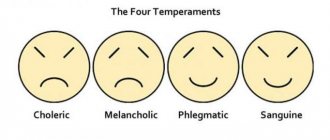Personal identification is a concept in psychology, which is considered as the identification of an individual with another, more significant or whole group, character from a literary work, film, etc. Often, by the word “identification” psychologists mean a defense mechanism in which a person unconsciously becomes like someone who causes fear and anxiety.
Identification in psychology
Identification in psychology
is considered as a natural process, unconscious or only partially conscious. Identification allows you to quickly and successfully adapt to society, promotes personal development and allows you to communicate easily.
As a psychological defense mechanism, identification occurs at an unconscious level. A person resorts to using projections associated with another, significant person. Identification is realized through the attribution of feelings and personal qualities inherent in another person.
Description of a person's appearance
To identify a person, anatomical and anthropological signs are used that characterize the external appearance of the human body as a whole and its individual parts, as well as some functional signs and anatomical and pathological changes (special features). Various signs of clothing and other things and objects that a person constantly or often uses are studied.
Description of anatomical features
Floor. Male, female.
Age. It is established on the basis of reliable data, and in the absence of data, approximately, “by sight.” The following age periods are distinguished: children - up to 12 years; teenage - 13-16 years old; youthful - 1721; young - 22-35 years old; average - 36-60 years; elderly - 61-75 years old and senile.
Nationality (face type). In the absence of reliable data, a comparative determination of the type of person is allowed. In forensic science, European, Mongolian, Caucasian and Central Asian facial types are distinguished.
Height. It is determined, as a rule, by a three-member gradation. For men: low - up to 160 cm; medium - up to 170 cm; high - up to 180 cm and above. For women, these limits are reduced by 8-11 cm.
Body type. It is determined by comparing height, shoulder width, length of the torso, legs, development of the chest and shoulder girdle muscles, taking into account the subcutaneous fat layer. There are people with athletic, stocky, average and weak builds. In terms of body fat, a person can be characterized as thin, of normal nutrition, or overweight.
Head. In relation to the body, the head can be small, medium and large; The shape of the parietal part is flat, dome-shaped, ovoid. The position of the back of the head relative to the vertical is beveled, vertical, and protruding. The face as a whole is described by its general configuration: round, oval, triangular, square, rectangular, diamond-shaped.
Hair. When describing hair, their presence, configuration, hairline, length, type of hairstyle (haircut) or degree of baldness are noted. Then a description of facial hair (mustache, beard, sideburns) is compiled.
Forehead. The description of the forehead is done in profile and from the front. In the profile, its inclination (position) from the vertical is noted: vertical, tilted forward and tilted back (Fig. 13.3.). The width of the forehead can be wide, medium and narrow, and the height - high, medium and low. A significant protrusion of the brow ridges and the presence of frontal tubercles are also recorded.
Brows. With respect to the horizontal, eyebrows are distinguished into oblique, horizontal and oblique. The criterion in this case (as in other cases) is a deviation from the horizontal by more than 5°. According to their position relative to the eyes, eyebrows can be high, medium and low. Along the contour of the upper edge, the eyebrows can be straight, arched, curved, broken, triangular.
Eyes. When determining the characteristics of the eyes, the following are distinguished: the structure of the palpebral fissure, the protrusion of the eyeballs in the orbits, the color of the iris. The palpebral fissure is described along its contour (oval, round, triangular, slit-like) (Fig. 13.4.); degrees of disclosure (medium, large, small); relative position of the corners of the eyes (horizontal, oblique internal, oblique external). Based on the position of the eyeballs in the orbits, eyes are distinguished between convex and sunken.
Eyelashes. Marked: length (long, medium, short), contour (straight, curved).
Nose. In relation to other elements of the face, the nose can be large, medium or small. The overall size of the nose depends on its height, width and protrusion. The height is determined in profile by the distance from the deepest place of the nose to the lower edge of the nasal septum. The nose can be medium, large (long) and small (short). The width of the nose is determined between the extreme points of its wings. Based on this parameter, a nose is distinguished between narrow, wide and medium. In terms of protrusion, the nose can be strongly, moderately and slightly protruding. The contour of the bridge of the nose is remembered quite well by eyewitnesses. In forensic science, it is customary to call the contour of the bridge of the nose straight, convex, concave and tortuous. The base of the nose can have three positions relative to the horizontal: raised, horizontal, lowered.
History of discovery and study
The concepts of “defense mechanisms” and “identification” were introduced into psychological science by Sigmund Freud. According to his interpretation, identification is:
- a defensive reaction that occurs against the background of fear of punishment for aggressive behavior or sexual attraction;
- unconscious identification of the subject with another against the background of fear of loss of love.
In psychoanalytic teaching, identification is considered as the only mechanism contributing to the formation of personality. Through unconscious identification, the child reproduces the parental image.
In behaviorism, identification is considered as a mechanism for the formation of social roles. It is associated with the need to reinforce secondary needs.
Development mechanism
Identification develops in several stages. The first occurs at the age of about 3 years, when the child begins to understand that he and his mother are not one whole, that another person is vying for the mother’s attention - the father. The child cannot compete with him for his mother, so he needs to develop paternal qualities in himself. This will allow later, already in adulthood, to win a “mother” - a woman who will become a companion.
The second stage of identification development occurs during adolescence. The period of separation is the time when a teenager moves more and more away from his parents and is left alone with the big world. To find external support, he needs another person or group with which to identify.
In the process of identification, a person gains new experience, acquires qualities that later help him determine his own vector of development. With the help of identification, a young child develops personal characteristics and behavioral patterns, and begins to understand his gender identity. Focusing on a meaningful image helps to overcome the feeling of one’s own weakness and inferiority.
2.2. Identity Policy
Identification of a person (person’s personal data) can be carried out in different ways:
- a single number that cannot be changed throughout your life
- a number that changes due to a change in a person’s data
— use of a set of numbers for identification
The issue of choosing identification methods is of decisive importance for the development of any information system that takes into account the personal data of citizens and other information that gives a person the opportunity to receive any services, both government and commercial.
Structure and functions
Identification occurs gradually. In the structure of the formation of this psychological defense mechanism, the following stages are distinguished:
- a connection arises with an important object on an emotional level, “trying on” the feelings of another person to oneself occurs;
- perception of an important object as oneself - the most striking features of another (an object to be imitated), his style of behavior, manner of speaking, spiritual values, beliefs, life guidelines, interests are integrated into the personality;
- own personal characteristics are assigned to a significant object. Your desires and feelings are attributed to a dear person.
Identification performs an adaptive function - an individual “takes” the traits of another person (or group) in order to be like him, to feel that he belongs to a clan.
Identification is a means that helps you immerse yourself in the world of another person, understand his thoughts and feelings.
Kinds
According to the psychoanalytic approach, a person can form a positive or negative identification. In the first case, the object is the one towards which the subject experiences predominantly positively colored emotions.
In the case when negative self-identification occurs, the object whose characteristics are assigned by the subject is viewed as an aggressor, a person who causes fear and anxiety.
There is also primary and secondary identification. The primary one is formed during the interaction of a person at an early age with a parent of the same sex. For a girl, the mother becomes the object, for a boy, the father becomes the object.
Secondary identification is formed on the basis of the child’s interaction with other people who are present nearby.
Several other subtypes of identification are considered in psychology.
Situational
In adults, this type of identification is updated when interacting with other, more significant adults, for example, during work meetings with subordinates or when meeting a new person. Children use this defense mechanism when playing together with peers in order to become like them. The function of this type of identification is to be as similar as possible to the currently significant person.
Group
This type of psychological defense is considered very stable. It is characterized by the fact that a person shares the moral values, views and foundations of the reference group, being in it and outside it.
In some cases, group identification appears only in certain situations - when a person is within a group. If he is outside the group, his views and behavior change, and his own prevail.
Cultural
Identification occurs through identification with the culture of a particular society. A person is well aware of his own potential and accepts the requirements of the society of which he is a part.
Social
A person realizes that he is an important element of society. He believes that his belonging to a certain group is very important, that he can represent values and protect the interests of the community.
Personal
A person identifies himself only with himself. He is aware of his own uniqueness and is not afraid to demonstrate it. This type of identification differs from others in that a person has a single system of views, beliefs, goals and interests. An individual’s belonging to any social group does not cancel his stable ideas about himself and does not change the set of his personal characteristics.
Collectivist
A defense mechanism is formed in a team member. When colleagues engage in joint activities, they transfer emotions to each other. Gradually, a common emotional background, mutual assistance, and sympathy are formed in the team. Participants in the collective process try to help their colleagues, share the joy of the successes achieved and the hardships associated with each other’s failures
Sexual
Formed in the first years of life. At the age of 2-3 years, the baby begins to show interest in his own body and associate himself with a certain gender.
Gender
It manifests itself through awareness of gender (it is not always identical to gender). Gender identification allows a person to understand who he feels like (a woman or a man).
3.2. Basic information resources
During the transition period (before the creation of a single basic information resource), it is permissible to use several basic information resources that have already accumulated a fairly large amount of information about citizens and continue to carry out this accumulation when performing their functions (in Russia these are the FMS, FNM, Pension Fund of the Russian Federation, Rosreestr, Ministry of Internal Affairs and a number of other resources). When using several basic information resources, it becomes necessary to solve a number of rather serious issues:
— definition of basic identifiers
— establishing correspondence of basic identifiers to each other
— identification of primary (master) resources that will serve as a standard for all others
— defining a procedure for correcting errors and introducing changes to the underlying resources if any are detected
If there are a large number of such resources, working with them will be very difficult, as well as the risk of a situation with incorrectly identified personal data of citizens.
Stages
The first stage of identification formation, which occurs at an early age, is very important for personality development. Not only S. Freud, but also other classical psychologists insisted on this. In the first years of life, identification occurs under conditions of high emotional load, but it also becomes a necessary condition for further alienation and the formation of one’s own ideas about oneself as a person.
In the process of differentiation by the child of himself and isolation from others, his independence grows, he begins to better understand himself as a source of activity. The child learns to act differently from others.
Jung believed that identification is necessary for the development of personality at a stage when there is no individual path yet. As soon as the opportunity arises to follow the path of individual development, identification turns from a factor stimulating development into an obstacle to it. Identification at the stage when a person must take his own path provokes dissociation and prevents him from gaining integrity. Jung believed that identification is a very important stage that precedes individuation.
As a person matures, the importance of identification decreases, while alienation, on the contrary, increases and reaches its maximum level in adulthood. The exception is during periods when a person goes through an identity crisis.
4.2. Creation of information (information) resources
After the regulatory and legal consolidation of the basics of identification, it is necessary to determine the basic principles for developing an information system (systems) that allow identification of citizens. This system (systems) must not only ensure the accumulation of information about citizens, but also have the entire infrastructure. Which will allow you to use this information resource, not only in the software part, but also in the technical support. The use of this resource everywhere must presuppose the presence of an extensive data transmission network, access to which must be provided from anywhere in the country (and from other countries as well), all principles of information security must be defined, ensuring protection from unauthorized access both from within and from the outside. In addition, the issues of ensuring sufficient productivity of this information resource must also be resolved, since information exchange with the basic information resource is several orders of magnitude higher than with resources used for any one field of activity.
Get text
Methods
Experimental methods of research in most cases focus on specific aspects - social roles, gender or group affiliation, personality characteristics. Such studies make it possible to identify the peculiarities of living certain identities and searching for a significant object for identification in different situations and areas of activity.
Difficulties arise when it is necessary to study not specific characteristics, but to form a holistic picture of the personality and its identity.
In order to explore the widest possible range of manifestations of identity, to understand with whom, with what and to what extent a person identifies himself, several diagnostic directions are used:
- Questionnaires to identify the level of attitude towards oneself and self-satisfaction. They are easy to use, easy to standardize and validate on a representative sample. Limitations to obtaining objective survey results may include cognitive biases related to self-perception, as well as socially desirable responses.
- Psychosemantic research methods - in them, the assessment of one’s own personality is considered through compliance with a certain set of criteria, which are not always socially approved.
- Projective techniques - they provide an opportunity to explore identity and self-awareness.
3.1. Single basic information resource
To organize interdepartmental interaction when providing any services to the population electronically, various methods of maintaining resources containing human identification data can be used. The ideal option is to have a single basic information resource. A resource that is primary for any other information resources that contain and accumulate data in the performance of their functions.
In the case of using a single basic information resource, any change in identification data about a citizen causes a change in this data in secondary resources, that is, the information stored in a single basic information resource is the only correct one for all others. This is an ideal situation.











